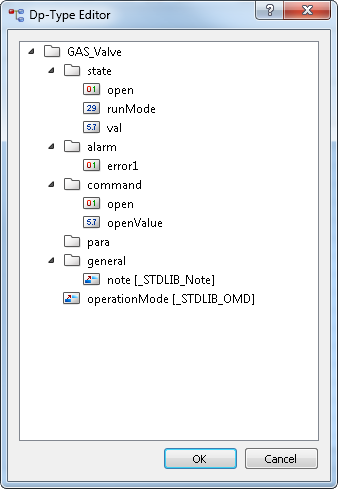How to Create Data Point Types for the Standard Object Library
Standard library specific data point types can be created by using the Standard Object Library Setup panel - see How to Create a Standard Object Library. These data point types are automatically added into a WinCC OA project when using the library.
From each one of these data point types - a type of template, a data point for every real device can be derived by the user of the library. The data point types for standard library are created by using a specific name pattern.
The following nodes (see below) belong to the Standard of the Stdlib and are automatically added to the library data point type when creating a data point type via the Standard Object Library Setup panel. Add, however, the necessary elements to the nodes manually according to your requirements - see example figure further below.
If you do not use the Standard Object Library Setup panel, you have to create a data point type manually. The data point types for standard library must be created by using a specific name pattern and structure - see the steps below.
 How to create a new data point type
How to create a new data point type
-
Open the WinCC OA PARA.
-
Right click on the tree view and select the option "Create datapoint type" from the context menu.
-
This opens the DP-Type editor, which allows the configuration of data point types.
-
Name the data point type in the following manner: Library-Projectname_in_capital _letters>_<individual_devicename>, e.g. GAS_Valve. The Stdlib data point type name must contain the prefix „<LIBRARYNAME_IN_CAPITAL_LETTERS>_
-
Beneath the data point type node, insert one or more further nodes. The following nodes belong to the Standard of the Stdlib and can be added to the library data point type:
| Node | Description |
| alarm |
Contains all numerical alert, warning and/or error alert elements. For every included data point element, an alert handling config must be created (see _alert_hdl). The alert handling config of the alarm node must be a sum alert handling that contains all alerts of this object. On the "alerts" tab of the sum alert handling, configure all included alerts under "DP-model". |
| state | Contains data point elements that save information about the current state/value of a data point. |
| command | Contains all command data point elements for control and manipulation of object types (values and states) if the object allows this. |
| para | This node is necessary for saving object specific information, such as informative texts, for example. |
| general | Depending on the object, here hierarchical levels can be added that contain general information about the object. An important element of this node is the note element with the embedded internal DP-type _STDLIB_Note. |
| operationMode | Defines the possible operating modes. The element references the internal DP-type _STDLIB_OMD. |
| infoArea | Is used for simple (without CTRL Logic) configuration of info area icons for a data point type: :STDLIB_MOD |

-
Confirm the structure of this data point type by clicking on "OK".
-
Right click on the tree view in PARA and select the option "Create master data point" from the context menu. Note that you cannot rename the data point type once a master data point has been created.
-
Add all necessary WinCC OA data point configs to the data point elements, e.g. alert handling for the alarm node or periphery address configs.
-
Create a new data point for the new data point type. You can choose the name of the data point since the data point is not included later in the library (only the data point type and the master data point).
-
Close the WinCC OA PARA.



